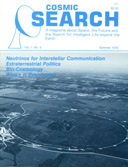![[NAAPO Logo]](../../Images/NAAPOsm.jpg) North American AstroPhysical Observatory (NAAPO)
|
|
Editorial: "The Stars on Radio"
On Sept. 19, while Menachem Begin and Anwar Sadat were down the hall, besieged by newsmen, a quiet little hearing was going on in the Rayburn Building before the House subcommittee on space science and applications, on the subject of the "Search for Extraterrestrial Intelligence." The cruel among you will now observe that the House might better limit its searches to terrestrial intelligence, but in fact the subcommittee had before it some fine examples of earthly brain work in the testimonies of Richard Berendzen of American University, Philip Morrison of the Massachusetts Institute of
Technology, A. G. W. Cameron of the National Academy of Sciences and several others. All of them had come to argue for a $14-million appropriation ($2 million a year for the next seven) to the National Aeronautics and Space Administration to improve radio technology, so that we may eventually determine if anybody up there likes us.
Actually, those distinguished scientists and their supporters would be more than pleased simply to hear from anybody up there, affection notwithstanding. They are placed in a defensive position now because NASA's proposal for FY79 has already been chopped up in the House and killed in the Senate. Naturally, one of the killers was Sen. William Proxmire (D-Wis.), who gave the proposal his Golden Fleece award, although what the scientists seek is far more interesting than Jason's quarry. The question of relative worth that Mr. Proxmire's award awkwardly implies, of course, is an old and real
one. But the cost — even to our unscientific ears — sounds awfully low for a project that
(1) would have scientific value even if we didn't hear a peep from the other planets and (2) would be astonishingly important if we did.
NASA could have hidden its proposal among other, less "scary" line items in its budget, since radio astronomy is a perfectly acceptable area of inquiry, without mentioning the search for transmissions from outer space. That NASA chose to play the matter straight is to its credit. It is also to the credit of the parent House Committee on Science and Technology that, even with the proposal dead for FY79, the committee still took the time to learn more about an endeavor whose own proponents admit may turn out to be a perpetual shot in the dark. The question now is: What happens when the proposal is raised again next year?
The answer should be: Fund it. There are plenty of social reasons against doing so, as there always are. And there are scientific reasons, too, since even some radio astronomers do not wish to divert their current work to a cause where the odds are so poor. But this is not one of those situations where we are likely to know without trying. The most interesting element in all this is that, if we ever should receive a comprehensible message, it will probably have been intentionally sent — meaning that whoever is up there has something to tell us. Perhaps to push ahead.
|
